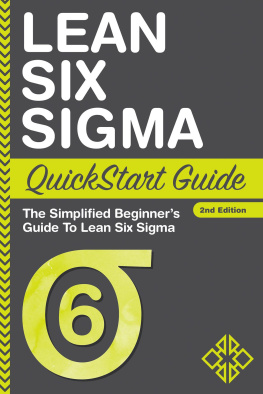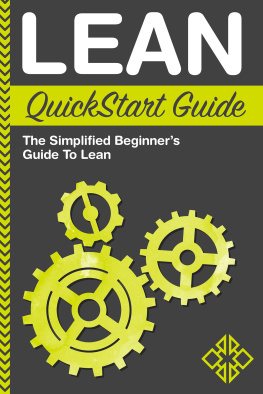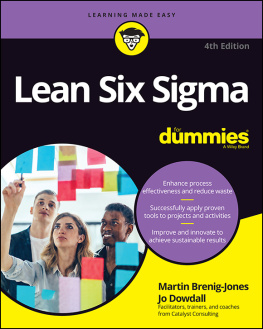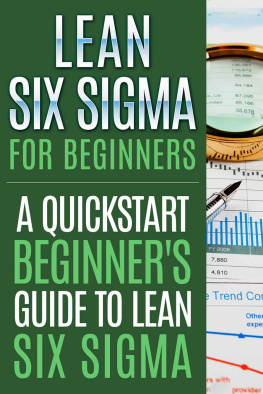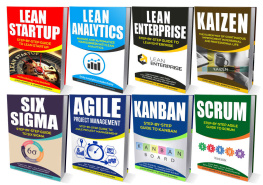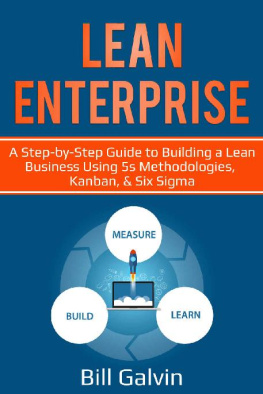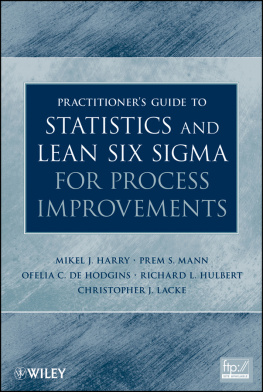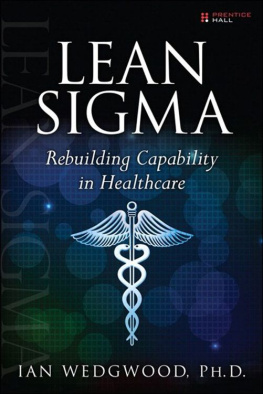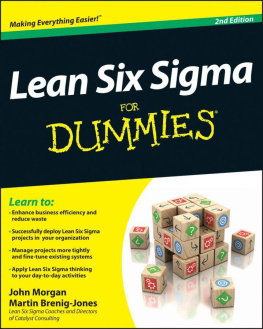Contents
Landmarks
Contents
Terms displayed in bold italic can be found defined in the glossary

BEFORE YOU START READING,
DOWNLOAD YOUR FREE DIGITAL ASSETS!
Visit the URL below to access your free Digital Asset files that are included with the purchase of this book.

DOWNLOAD YOURS HERE:
www.clydebankmedia.com/leansix-assets
Introduction
In the ever-changing business market, one thing is certain: organizations that want to survive must find their own source of competitive edge. One way to secure a lasting advantage is through the optimization of business functions and processes. This is certainly an easier said than done scenario, and as the organization grows, the more daunting the challenge appears. Decision makers are nearly inundated with the variety of business improvement methods, optimization programs, and best practice solutions that exist in todays market.
This book introduces readers to the hybrid solution Lean Six Sigmaits constituent elements, how it operates, what tools are available to organizations that utilize Lean Six Sigma, and what criticisms of the program exist.
Lean Six Sigma is born out of a combination of the best parts of both the Japanese automobile manufacturer Toyotas Lean production system and Motorolas quality control program, Six Sigma. As we will see, each program offers significant merits in its own right, and each contributes to the hybrid systems effectiveness and implementation.
However, there are no one-size-fits-all solutions for every organization; the right decision for any business is an informed one. This is a key part of understanding each of the options and methods that are available and how they interact with an organizations operations and structure.
Lean and Six Sigma are both derived from the production and manufacturing sector, but both programs have applications outside the industry of their origin. Leans focus on detecting and eliminating waste has applications throughout many types of business operations and a variety of industries. Six Sigmas customer-centric quality improvement programs can be applied to many quantifiable business processes in the service industry as well as its home industrial sector.
How to Use This Book
This book has a progressive structure. Lean Six Sigma is a hybrid system of management, and the text therefore begins with descriptions of the two component systems before diving into an analysis of Lean Six Sigma itself.
The chapters that follow describe how the system has been utilized in the manufacturing sector and where it originated, as well as explorations of other industries where the method may be used to substantial effect. Methods, tools, and best practices are all included within this text, as well as a structured examination of the ways in which the elements of Lean Six Sigma can be used to improve an organizations quality, efficiency, and complexity.
Criticism of Lean Six Sigma is discussed in its own chapter. The final chapter, which discusses the Lean Six Sigma consultation industry, highlights the salient questions surrounding the use of outside management experts. The purpose of this book is to provide basic introductory insight into Lean Six Sigma and its real-world implementation for professionals and students alike.
| 1 | An Introduction to Six Sigma
In This Chapter
- An overview of the Six Sigma method is covered
- An exploration of the concept of standard deviation and its relevance to Six Sigma is explained
- The core methods of DMAIC & DMADV are illustrated
- Staff implications and the Six Sigma organizational hierarchy are discussed
Six Sigma is a quality improvement oriented process management system. It uses statistical tools and empirical techniques to reduce the number of defects within a process to a miniscule level. Developed by the multinational telecommunications company Motorola in 1986, it has evolved into a process-focused business strategy and manufacturing tool that promises highly sought-after results.
In 2005, nineteen years after the conception and adoption of Six Sigma, Motorola claimed to have saved over $17 billion thanks to their adherence to Six Sigma. The continued adoption and implementation of the programnow thirty years oldby Fortune 500 companies and global market players demonstrates its efficacy and staying power as a business improvement tool. In 2011the International Organization for Standardization (ISO) cemented Six Sigma as a business improvement process with the 13053:2011 ISO standardized definition.
Like many quality improvement strategies, the exact practical implementation of Six Sigma varies from industry to industry and product to product, but the entire program is shaped around a doctrine of several guiding precepts. Many of these defining principles are evident in traditional quality improvement programs as well, and the program of Six Sigma methodologies is also derived from this venerated framework.
Note that the umbrella term process is used here and elsewhere in this text. While Six Sigma was introduced as a manufacturing process improvement tool, it is applicable to nearly all quantifiable business processes. The most notable of these non-manufacturing quantifiable processes are the fields of billing and call center or support center efficiency control. The ubiquity of these business activities means that Six Sigma has the potential to spread to all corners of the business world, at least in some capacity.
Core Doctrine
The core doctrines that guide the Six Sigma program can be represented by three key elements. These elements are broad-strokes concepts that serve to inform both adherents to the methodology and those seeking to understand it at its most basic levels.
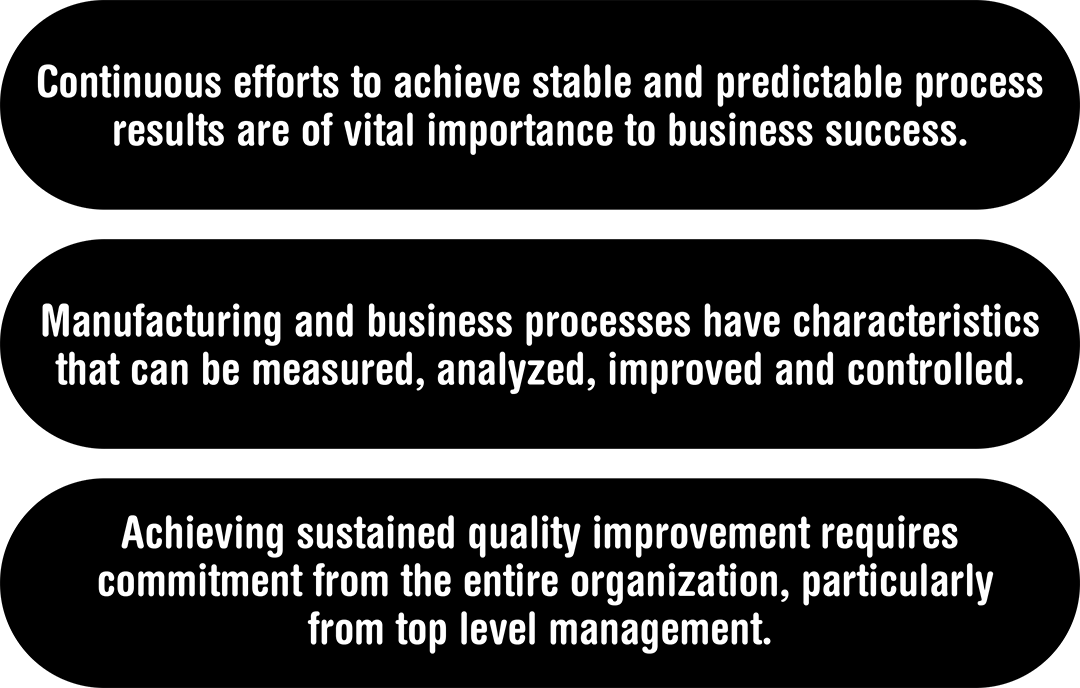
The first portion of the Six Sigma core doctrine represents the general aim of most quality improvement programs: the reduction of variation, resulting in increased quality. In the world of Six Sigma manufacturing, the type of variation most often addressed is the defect rate, measured as the defects per million opportunities (DPMO) .
Defects incur costs, and costs affect profits. A common aim of the Six Sigma program is to achieve what is known as Six Sigma quality, a term that refers to processes that produce a defect rate less than or equal to 3.4 DPMO.
To put that in perspective, that same defect rate expressed as a percentage means that defects will occur .00034 percent of the time. However, this proportion does not necessarily represent the number of defects that a process can allow under the Six Sigma approach; the exact allowable percentage should be determined by quality control experts and resource planning personnel within each business unit that implements Six Sigma on a product-by-product basis.
Because the term comes up frequently, it is important to define what a defect is. In the Six Sigma process, defects are unwanted variations in the manufacturing process that fall outside of the customers specifications. This is an extremely broad definition and intentionally so. Defects are commonly thought of as errors such as drilling a bowling ball with two holes instead of three, but the Six Sigma definition also includes non-production aspects that fail to meet the customers expectations, such as late delivery.

